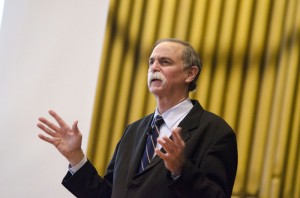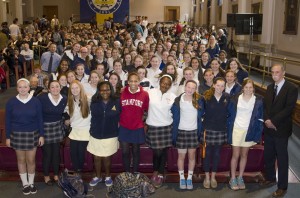David Wineland, recipient of the 2012 Nobel Prize in physics, visited Drexel University April 15 as the 18th Kaczmarczik Lecturer. He is the second consecutive Nobel laureate to speak in the lecture series.
Wineland, who has been with the National Institute of Standards of Technology since 1975, was cited in his Nobel award for “groundbreaking experimental methods that enable measuring and manipulation of individual quantum systems.” His work in quantum optics has allowed for the measurement of superposition states, which are the occurrence of two distinctly different states simultaneously. Observations of this kind were long thought to be impossible, dating back to the early days of quantum physics. The implications of such an observation were most famously described by Erwin Schroedinger in a thought experiment now known as Schroedinger’s Cat.
In the thought experiment, “you have a situation where there is a single radioactive particle, and also in this box there’s a cat. And there’s some mechanism where if the particle decays it will release poison and kill the cat,” Wineland said. While we could in theory write out the equations to represent the situation, in effect, “all we can say is that the cat exists in a situation where it’s simultaneously dead and alive. It’s not dead or alive, it’s dead and alive,” he explained. Generally, measuring these superpositions causes them to collapse into one state or the other, but the reason Wineland’s research is so innovative is that it enabled the team at NIST to measure and manipulate superposition states without collapsing them.
The foreseeable implications of this work are in atomic clocks and quantum computing, but it is impossible to say where it will be most important. “More often than not, when a field is developed, you don’t know what the applications are when you’re doing it. Very likely the useful applications will maybe be things we’re not thinking about. A good example of that would be the laser. When it was first developed, people didn’t really have an idea what it would be good for. Maybe they had some simple ideas, but now it’s ubiquitous in our lives. I’d like to believe that the same stuff will happen with this stuff that we’re doing,” Wineland said.
Already, the time and frequency group at NIST has built an atomic clock using aluminum ions that is accurate to one part in 10^17, meaning that if the clock had been started 13.7 billion years ago, right at the Big Bang, it would be accurate to within five seconds today.
Quantum computing is in its infancy, but it could be a revolution on a scale not seen since the microprocessor. The smallest unit of information on a regular computer is called a bit and can be either a one or a zero. In a quantum computer, quantum bits, or qubits, are in a superposition of both one and zero simultaneously. This means that two qubits could simultaneously take on four values, and a computer with 300 qubits could hold 2300 values concurrently, more than the number of atoms in the universe.
Wineland’s talk focused on his career trajectory and the research he has performed over the years. He completed his undergraduate studies at the University of California, Berkeley; went on to graduate work at Harvard University under Norman Ramsey, where his thesis was titled “The Atomic Deuterium Maser”; and then to postdoctoral research at the University of Washington in Hans Dehmelt’s lab, where he worked on electron and ion traps. Both Ramsey and Dehmelt were awarded the Nobel Prize in physics in 1989 for separate research.
Promoting physics as a field is one goal of Wineland’s, and he acknowledges that basic science might be losing out to the many distractions available to students. But, he said, “One of the things that’s been nice about this job is that it really is more like a hobby. I’ve been able to determine what I work on, and there’s this wonderful freedom to work on interesting problems. I think if you can get that message across to young people, it might attract more of them.”
“One of the biggest takeaways from things like this, even if you don’t understand all of the details, is the work it took to get where the scientist is,” Michael Schlenker, a first-year physics graduate student, said. The people who win these awards are “people with a passion for what they do, and that passion comes out in this kind of talk.”
The lecture series was established to honor Paul Kaczmarczik, a physics professor who started teaching at Drexel in 1953 and retired in 1989. “Dr. Kaczmarczik was known for being the professor that got all students to understand some of the basic principles of physics, regardless of their major. He made physics real and tangible to everybody,” Donna Murasko, dean of the College of Arts and Sciences, said. “The fact that we have almost 500 high school students with us today is a part of this program that makes this so much what Dr. Kaczmarczik would have liked.”




